This post interrupts my trilogy of reports on the World Series of 50, 75 and 100 years ago. You have seen the post on 1917, but my 1942 post will need more setup because it is about TWO World Series in the same year. So a little history may help before we get to the games played in 1942.
MLB World Series – A Brief History: The National League was founded in 1876. Other leagues followed, but no other “major” league endured until the American League transitioned to that status in 1901. The American League was able to upgrade by poaching stars from the National League which had a maximum player salary. The two leagues made peace after the 1902 season with an agreement not to raid each other for players. This set the stage for other interleague cooperation.
In 1903, the pennants were won by the NL Pittsburgh Pirates and the AL Boston Americans (Red Sox). The two teams agreed to play a nine-game series to determine the best team in baseball. Although these games were played 114 years ago, most baseball fans of today will recognize the name of a player from each team.
The Pittsburgh star was Honus Wagner, probably the best shortstop of all time. His playing stats are impressive, but the reason his name resonates over a century later is because of a very different stat: the auction prices paid for his baseball cards. The story of his card fame was told in Hot Stove #7, but here is a recap. One of the most treasured series of baseball cards was issued by the American Tobacco Company from 1909 to 1911 (identified by collectors as T206, the “T” indicating tobacco). When I wrote Hot Stove #7 in February of 2016, the highest price ever for a baseball card was the $2.8 million paid in 2007 for a T206 Wagner. That was topped in October of 2016 when another Wagner T206 card sold for $3.12 million.
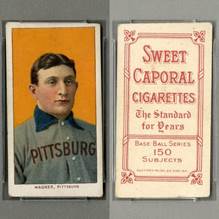
The star pitcher for Boston was Cy Young who won 28 games that year and 511 in a remarkable 22-year career. When the award for the best pitcher in baseball was established in 1956, it was appropriately named the Cy Young Award. The first winner Don Newcombe of the Dodgers, and his teammate Sandy Koufax won in 1963, 1965 and 1966. In 1967, the award was expanded to honor the best pitcher in each league. The most Cy Young Awards have gone to Roger Clemens who won seven. Cy Young also had a card in the T206 series, but he had moved on to Cleveland by then.
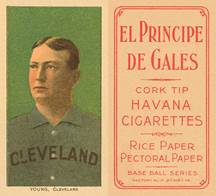
In the 1903 World Series, Boston surprised Pittsburgh and won five games to three. Cy Young won two games. Honus Wagner hit only .222.
Some folks in the National League were not pleased with being upstaged by the Boston win. So in 1904, when Boston again won the AL pennant, the NL pennant winning New York Giants refused to play. There was no agreement between the leagues requiring that the two pennant winners have a postseason series. Baseball fans and players were not happy, and so the leagues firmed up an agreement and resumed the World Series in 1905.
From 1903 through 2017, the MLB World Series has been played 113 times. The two missing years are 1904 when the Giants refused to play and 1994 when the season was cut short by a labor dispute.
Negro League World Series – A Brief History: The Negro National League (NNL) was founded at the Paseo YMCA in Kansas City in 1920. The Eastern Colored League (ECL) was organized in 1923. The leagues competed with each other for players, much like the National and American Leagues had done in the early 1900’s. MLB Commissioner Kenesaw Landis was asked to arbitrate, and the leagues resolved their issues on player contracts and set up a postseason championship.
The first “Negro World Series” (a/k/a “Colored World Series”) was held in 1924. Many newspapers serving the black community simply called it the “World Series,” and why not? The opponents were the NNL’s Kansas City Monarchs and the ECL’s Hilldale Club (from Darby, PA, near Philadelphia).
The photo below shows the teams before Game 5 in Kansas City at Muehlebach Field at 22nd and Brooklyn. The stadium was built in 1923 and named for George Muehlebach who owned the minor league Kansas City Blues, Muehlebach Beer and the Muehlebach Hotel.

The Monarchs won the 1924 Series, and the same two teams met in the 1925 Series, which was won by Hilldale. The Chicago American Giants won in 1926 and 1927, but the ECL folded in 1928, ending the NNL/ECL rivalry.
In the midst of the Depression, the NNL also folded. A second Negro National League was started in 1933, but the Monarchs remained independent until they joined the new American Negro League in 1937. Starting in 1942, the two leagues met for seven years in a World Series. The first pitted the two most honored teams in Negro League history, when the Kansas City Monarchs prevailed over the Homestead Grays. The Grays would come back to win the Series three times. Of the 11 Negro League World Series, the Grays were in five and the Monarchs in four.
The Monarchs returned to the World Series in 1946 and were defeated by the Newark Eagles. The Newark team was notable for having Hall of Famers Leon Day, Larry Doby and Monte Irvin, as well as being owned by Effa Manley, the only woman inducted into the Hall of Fame.
The breaking of the color line by Jackie Robinson spelled the beginning of the end for the Negro Leagues. The last Negro League World Series was in 1948 when the Homestead Grays beat the Birmingham Black Barons. In the outfield for the Barons was high school student Willie Mays who played only on weekends until summer vacation started. He continued to play for the Barons in 1949 and into the spring of 1950. In June, soon after he graduated from high school, the New York Giants bought his contract from the Barons. Willie would be in his next World Series in 1951 after Bobby Thomson hit his famous homer to win the pennant for the Giants.
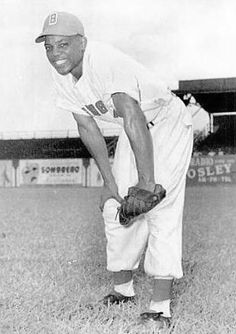
Willie Mays at Birmingham
All-Star Games – Also Brief: The MLB version of the All-Star Game began with what was intended to be a one-time event held at Comiskey Park during the 1933 World’s Fair in Chicago. It was the brainchild of Arch Ward, sports editor of the Chicago Tribune. The response was so good that it became an annual event. The only year missed was 1945 due to war travel restrictions.
From 1959 to 1962, there were two All –Star Games each season, so the overall total games to date is 88. Hank Aaron has appeared the most times, 25. His career was only 23 years, but it overlapped the two-game years. Same for Stan Musial and Willie Mays who each played in 24 All-Star games in their 22-year careers.
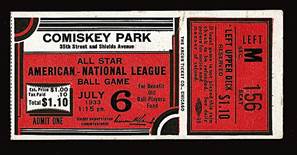
The MLB All-Star Game prompted Pittsburgh sportswriters Roy Sparrow and Bill Nunn to suggest to Pittsburgh Crawfords’ owner Gus Greenlee that the Negro Leagues likewise schedule an all-star game. It was played about two months after the inaugural MLB game and was at the same venue, Comiskey Park. The game was then played annually until 1962, sometimes two per season, bringing the overall total to 35 games. The last game was played on August 27, 1962, at Municipal Stadium in Kansas City. Jackie Robinson played in the 1945 game as a Kansas City Monarch.

Since there were not always two well-organized Negro Leagues, the teams were selected geographically – hence, the East-West All-Star Game. Most of the games were played at Comiskey because the Chicago black population reliably filled the stadium. Many of the games drew over 50,000 fans, often more than their MLB counterpart. As noted by Larry Lester, “The East-West All-Star Game was the biggest event in black America except a Joe Louis fight.” Lester is a Kansas City-based Negro Leagues historian, and one of his books chronicles this all-star history.
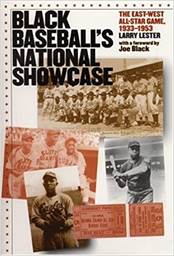
The top vote-getter from the newspaper ballots for the inaugural 1933 East-West game was Oscar Charleston of the Pittsburgh Crawfords. His statue stands in center field of the Field of Legends at the Negro Leagues Baseball Museum. Which leads us to…
Negro League Baseball Museum – Field of Legends – Umpire Bob Motley: This is an update of Hot Stove #41. I had reported on a fund raiser held this past April and organized by former city councilman Dick Davis who had an inspired idea: commissioning a statue of umpire Bob Motley to add to the Field of Legends at the Negro Leagues Baseball Museum. Those of us at the fund raiser were honored by the presence of the 94-year old Motley, the sole surviving umpire from the Negro Leagues. To remind you of the style that made him a legend, I’ll repeat a photo from that post:
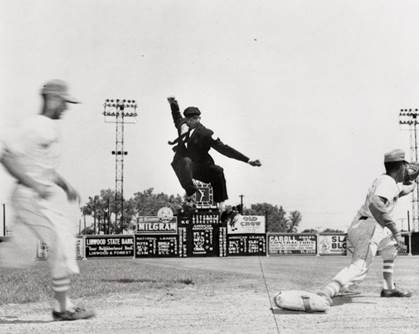
The fund raising campaign was a resounding success, and the work began at the Olathe studio of sculptor Kwan Wu. Wu is also the sculptor for the other 12 statues on the Field of Legends and of George Brett at Kauffman Stadium.
In August, Bob Motley was honored at a game at Dodgers Stadium, shown below being greeted by Don Newcombe, the inaugural Cy Young Award winner who got his start with the Newark Eagles in the Negro Leagues.
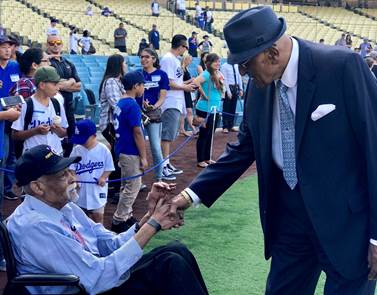
Bob Motley died on September 14. Although he did not get to see his statue in final form, he had seen a photo of the mold and knew he would soon be on the Field of Legends.
Last Wednesday night, Rita and I attended the unveiling of the statue at the museum. It was a heartwarming event, especially the gracious response by Bob Motley’s son Byron. Also participating in the unveiling were County Executive Frank White, City Councilmen Dan Fowler and Jermaine Reed, NLBM President Bob Kendrick and Project Chairman Dick Davis.
The photo below shows the statues of catcher Josh Gibson and umpire Bob Motley in their crouched positions behind home plate. The batter at the right is Martin Dihigo, and out of the picture is Satchel Paige on the mound waiting to throw his next pitch. Behind Motley and Gibson, but hidden by the non-statues in the photo, is Buck O’Neil perched in the dugout. Also, starting at the left: Kwan Wu, Bob Kendrick, Motley’s children Byron and Bobette, Dick Davis, Frank White, Jermaine Reed and Mike Carter.
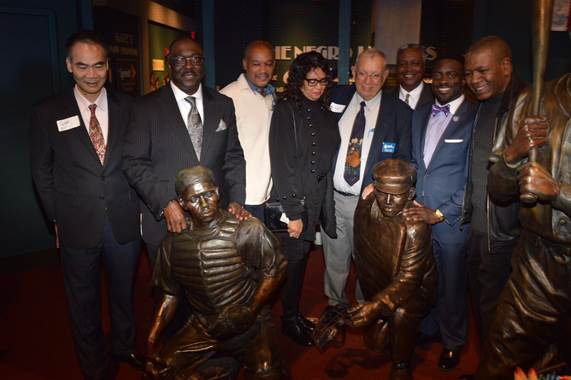
One more photo from the event, Rita and Lonnie with President Bob Kendrick.

Coming Attractions: Next, the two sets of World Series games played in 1942. Then, the 1967/Summer-of-Love World Series between the Red Sox and Bob Gibson.